Predicting the Average Compression Strength of CLT by Using the Average Density or Compressive Strength of Lamina
Abstract
:1. Introduction
2. Materials and Methods
2.1. Properties of the Lamina
2.2. CLT Sample Preparation and Testing
2.3. Probability Distribution and Kolmogorov–Smirnov Test
3. Derivation Method
3.1. Derivation of Formula for Calculating the Average Compressive Strength of CLT
- Assuming that no gap exists between the lamina, the effect of the gap on the cross-sectional area of the CLT need not be considered.
- Variations in the width and thickness of the lamina are considerably smaller than the variation in strength; the small differences in the cross-sectional areas of the lamina hardly affect the calculation result. Assuming that the cross-section of the lamina is equal to A, then the cross-sectional area of CLT can be expressed as Formula (6), as follows:
- Assuming that the resistance of CLT contributed by the lamina in cross layers is equal to K times of the resistance of the lamina in the major direction with the same cross-section, Formula (7) is obtained:
3.2. Predictive Modeling of the Compressive Strength of Lamina
3.2.1. The Linear Correlation between the Density and Compressive Strength of Lamina
3.2.2. The Linear Correlation between the Density and Compressive Strength of Lamina
- (1)
- Determine the density and compressive strength of the lamina. All lamina specimens with indexes are added, and all lamina with test results are listed on a table or saved on a database.
- (2)
- Randomly sample 10 lamina specimens without replacement from the measured data.
- (3)
- Calculate the average compressive strength and average density of the 10 lamina specimens.
- (4)
- Repeat procedures (2) and (3) 10,000 times, and save all average values.
- (5)
- Generate a scatter plot of the average density and compressive strength, with the density and compressive strength represented by the X and Y axes, respectively.
- (6)
- Build a model to predict the average compressive strength of the lamina by using the average density of lamina. Determine the parameters of the linear regression model and the formula written as Formula (15).
3.2.3. Average Compressive Strength of Lamina Sorted by Density
4. Results and Discussion
4.1. Experimental Results
4.2. Probabilistic Distribution of the Density and Compressive Strength of Lamina
4.3. Relationship between the Compressive Strength and Density of Lamina
4.3.1. Linear Correlation of the Measured Data
4.3.2. Linear Correlation of the Mean of the Measured Data, Calculated by Monte Carlo Simulation
4.3.3. Linear Correlation of the Mean of the Measured Data Grouped by Density
4.3.4. Comparison of the Four Prediction Models
4.4. Relationship between the Compressive Strength and Density of Lamina
4.4.1. Determination of the K Value
4.4.2. Prediction of the Average Compressive Strength of CLT by Using the Average Density of the Lamina
5. Conclusions
- The average compressive strength and density of the lamina in this study are approximately about 64.20 MPa and 0.62 g/cm3, respectively. Three distribution models—the normal, log-normal, and Weibull distribution models—can be used to fit the probability distribution of density test results for the lamina. Moreover, the symmetric normal distribution model ( =0.62 g/cm3, = 0.05) shows the best goodness-of-fit of density; both normal and Weibull distribution models can be used to fit the probability distribution of the compressive strength of lamina. The asymmetric Weibull distribution model ( = 67.45 MPa, = 9.77) shows the best goodness-of-fit of compressive strength.
- Compared with the lamina, CLT has a smaller variation in compressive strength and density because of homogenization effect of CLT; the width of CLT exerts no significant effect on the average compressive strength and density of CLT but affects the variations of the compressive strength and density of CLT. This observation indicates that the wider CLT has a smaller variation, and such a wider width further improves the design value of the compressive strength.
- The average compressive strength of CLT is approximately 72% of the average compressive strength of the lamina, they are about 46.15 MPa and 64.20 MPa, respectively. This result proves that the lamina in cross layers further improves the compressive strength of CLT and should not be ignored in calculating progress. The average compressive strength of CLT with three layers can be calculated according to the formula (K = 0.16 in this study) by using the average compressive strength of the lamina, and the compressive strength of CLT with i layers in the major direction and j layers in the minor direction can be determined using the formula (the K value depends on the CLT layers and layup, and it is bigger than zero).
- The compressive strength is linearly correlated with and density of the lamina. The linear correlation between the average compressive strength and average density of the lamina expressed as equation = 103.10 × (R2 = 0.999). Built by Monte Carlo simulation, the equation can be used to predict the average compressive strength of the lamina for the following reasons: This model has a great correlation coefficient, good prediction accuracy, and an average prediction error pf about 2.1% of the average compressive strength.
- The average compressive strength of CLT with three layers can be calculated according to the equation = 74.23 × by using the average density of the CLT or lamina. To some extent, the formula can be used to predict the average compressive strength of CLT with i layers in the major direction and j layers in the minor direction, while the K and a value depends on the CLT layers and wood species).
Author Contributions
Funding
Data Availability Statement
Acknowledgments
Conflicts of Interest
References
- Brandner, R.; Flatscher, G.; Ringhofer, A.; Schickhofer, G.; Thiel, A. Cross laminated timber (CLT): Overview and development. Eur. J. Wood Prod. 2016, 74, 331–351. [Google Scholar] [CrossRef]
- He, M.; Sun, X.; Li, Z. Bending and compressive properties of cross-laminated timber (CLT) panels made from Canadian hemlock. Constr. Build. Mater. 2018, 185, 175–183. [Google Scholar] [CrossRef]
- Connolly, T.; Loss, C.; Iqbal, A.; Tannert, T. Feasibility Study of Mass-Timber Cores for the UBC Tall Wood Building. Buildings 2018, 8, 98. [Google Scholar] [CrossRef] [Green Version]
- Fortune, A.; Quenneville, P. Feasibility study of New Zealand radiata pine cross-laminated timber. N. Z. Timber Des. J. 2011, 19, 3–7. [Google Scholar]
- Brandner, R.; Schickhofer, G. Properties of cross laminated timber (CLT) in compression perpendicular to grain. In Proceedings of the 1st International Network on Timber Engineering Research (INTER) Meeting, Karlsruhe, Germany, 1–4 September 2014. [Google Scholar]
- Sikora, K.S.; McPolin, D.O.; Harte, A.M. Effects of the thickness of cross-laminated timber (CLT) panels made from Irish Sitka spruce on mechanical performance in bending and shear. Constr. Build. Mater. 2016, 116, 141–150. [Google Scholar] [CrossRef] [Green Version]
- Saavedra Flores, E.I.; Saavedra, K.; Hinojosa, J.; Chandra, Y.; Das, R. Multi-scale modelling of rolling shear failure in cross-laminated timber structures by homogenisation and cohesive zone models. Int. J. Solids Struct. 2016, 81, 219–232. [Google Scholar] [CrossRef]
- Ostman, B.; Schmid, J.; Klippel, M.; Just, A.; Werther, N.; Brandon, D. Fire Design of Clt in Europe. Wood Fiber Sci. 2018, 50, 68–82. [Google Scholar] [CrossRef]
- Adekunle, T.O. Thermal performance and apparent temperature in school buildings: A case of cross-laminated timber (CLT) school development. J. Build. Eng. 2021, 33, 101731. [Google Scholar] [CrossRef]
- Serrano, E.; Enquist, B. Compression strength perpendicular to grain in cross-laminated timber (CLT). In Proceedings of the WCTE2010, Trentino, Italy, 20–24 June 2010. [Google Scholar]
- Brandner, R. Cross laminated timber (CLT) in compression perpendicular to plane: Testing, properties, design and recommendations for harmonizing design provisions for structural timber products. Eng. Struct. 2018, 171, 944–960. [Google Scholar] [CrossRef]
- Pei, S.; Rammer, D.; Popovski, M.; Williamson, T.; Line, P.; van de Lindt, J.W. An overview of CLT research and implementation in North America. In Proceedings of the WCTE 2016, Vienna, Austria, 22–25 August 2016. [Google Scholar]
- Brandner, R.; Tomasi, R.; Moosbrugger, T.; Serrano, E.; Dietsch, P. Properties, Testing and Design of Cross Laminated Timber: A State-of-the-Art Report by COST Action FP1402/ WG 2; Shaker Verlag GmbH: Düren, Germany, 2018; ISBN 978-3-8440-6143-7. [Google Scholar]
- Oh, J.-K.; Lee, J.-J.; Hong, J.-P. Prediction of compressive strength of cross-laminated timber panel. J. Wood Sci. 2015, 61, 28–34. [Google Scholar] [CrossRef]
- Sylvain, G.; Marjan, P. Chapter 3 structural. In CLT Handbook: Cross-Laminated Timber Canadian Edition; FPInnovations: Québec, QC, Canada, 2011. [Google Scholar]
- Karacabeyli, E.; Douglas, B. Chapter 3 structural. In CLT Handbook: Cross-Laminated Timber US Edition; FPInnovations: Pointe-Claire, QC, Canada, 2013. [Google Scholar]
- Bodig, J.; Jayne, B.A. Mechanics of Wood and Wood Composites; Krieger Pub, Co.: Malabar, FL, USA, 1982. [Google Scholar]
- Ren, H.Q.; Nakai, T. Intratree Variability of Wood Density and Main Wood Mechanical Properties in Chinese Fir and Poplar Plantation. Sci. Sin. 2006, 42, 13–20. [Google Scholar]
- Zhao, X.; Guan, S.; Cui, Y.J.; Huang, Z.H. Probability Distribution of Compressive Strength for Structural Dimension Lumber. For. Sci. Technol. 2013, 38, 41–44. [Google Scholar]
- Ren, H.Q.; Guo, W.; Fei, B.H.; Wang, Z.H.; Luo, X.Q. Mechanical Stress Grading of Chinese FIr Dimension Lumber for Light Wood Structure Houses. J. Build. Mater. 2010, 13, 363–366. [Google Scholar]
- Binder, K.; Heermann, D.W. Monte Carlo Simulation in Statistical Physics: An Introduction; Graduate Texts in Physics; Springer International Publishing: Cham, Switzerland, 2019; ISBN 978-3-030-10757-4. [Google Scholar]
- Chen, C.; Zhang, Q.; Keer, L.M.; Yao, Y.; Huang, Y. The multi-factor effect of tensile strength of concrete in numerical simulation based on the Monte Carlo random aggregate distribution. Constr. Build. Mater. 2018, 165, 585–595. [Google Scholar] [CrossRef]
- GB 5005; Code for Design of Timber Structures. Ministry of Housing and Urban Rural Construction of the People’s Republic of China: Beijing, China, 2017.
- GB/T 28993-2012; Standard Test Methods for Mechanical Properties of Structural Lumber. Standardization Administration of the People’s Republic of China: Beijing, China, 2012.
- ASTM D198-15; Standard Test Methods of Static Tests of Lumber in Structural Sizes. ASTM International: West Conshohocken, PA, USA, 2015.
- ANSI/APA PRG 320: 2018; Standard for Performance-Rated Cross-Laminated Timber. American National Standards Institute/APA-The Engineered Wood Association and Others: Tacoma, WA, USA, 2018.
- Ranta-Maunus, A.; Fonselius, M.; Kurkela, J.; Toratti, T. Reliability Analysis of Timber Structures; VTT Tiedotteita—Meddelanden—Research Notes; VTT Technical Research Centre of Finland: Espoo, Finland, 2001; ISBN 951-38-5908-8. [Google Scholar]
- Owens, F.C.; Verrill, S.P.; Shmulsky, R.; Kretschmann, D.E. Distributions of MOE and MOR in a full lumber population. Wood Fiber Sci. 2018, 50, 265–279. [Google Scholar] [CrossRef] [Green Version]
- Pellicane, P. Goodness-of-fit analysis for lumber data. Wood Sci. Technol. 1985, 19, 117–129. [Google Scholar] [CrossRef]
- Zhong, Y.; Wu, G.F.; Ren, H.Q. Reliability analysis and design value on bending strength of domestic dimension lumber for structural purpose. J. Build. Struct. 2018, 39, 119–127. [Google Scholar]
- Lilliefors, H.W. On the Kolmogorov-Smirnov Test for Normality with Mean and Variance Unknown. J. Am. Stat. Assoc. 1967, 62, 399–402. [Google Scholar] [CrossRef]
- Parsons, F.G.; Wirsching, P.H. A Kolmogorov—Smirnov goodness-of-fit test for the two-parameter weibull distribution when the parameters are estimated from the data. Microelectron. Reliab. 1982, 22, 163–167. [Google Scholar] [CrossRef]
- Mooney, C.Z. Monte Carlo Simulation; Sage: Thousand Oaks, CA, USA, 1997. [Google Scholar]
- Xing, X.T.; Zhang, S.N.; Zhao, C.; Ren, H.Q.; Zhou, H.B. Study on the mainly wood physical and mechanical properties of import lumber of Larix Kaempferi Carr. Wood Process. Mach. 2017, 1, 9–12. [Google Scholar]
- Schickhofer, G.; Brandner, R.; Bauer, H. Introduction to CLT-product properties-strength classes. In Proceedings of the Joint Conference of COST Actions FP1402 & FP1404, Cross Laminated Timber-A Competitive Wood Product for Visionary and Fire Safe Buildings, Stockholm, Sweden, 3 October 2016; pp. 9–32. [Google Scholar]
- Wei, P.; Wang, B.J.; Li, H.; Wang, L.; Peng, S.; Zhang, L. A comparative study of compression behaviors of cross-laminated timber and glued-laminated timber columns. Constr. Build. Mater. 2019, 222, 86–95. [Google Scholar] [CrossRef]
- Tian, Z.P.; Wang, Z.H.; Wang, J.L.; Zhang, Z.L.; Ge, B.Q.; Lu, Y.B.; Ren, H.Q. Classification in Modulus of Elasticity and Mechanical Properties of Larch in Mohe. J. Northwest For. Univ. 2017, 32, 211–215. [Google Scholar]
- Li, Z.Y.; Zhang, S.H.; Liu, H. The variation of wood density and strength of Northeast pine and larch and classification according to wood stress. Sci. Silvae Sin. 1986, 22, 380–392. [Google Scholar]
- Chowdhury, M.Q.; Ishiguri, F.; Hiraiwa, T.; Matsumoto, K.; Takashima, Y.; Iizuka, K.; Yokota, S.; Yoshizawa, N. Variation in anatomical properties and correlations with wood density and compressive strength in Casuarina equisetifolia growing in Bangladesh. Aust. For. 2012, 75, 95–99. [Google Scholar] [CrossRef]
- Gong, Y.; Ye, Q.; Wu, G.; Ren, H. Prediction of the compressive strength of corss-laminated timber based on Monte Carlo Simulation. J. Northwest For. Univ. 2020, 35, 240–243. [Google Scholar]
- Sun, H.; Ji, X.; Zhao, H.; Yang, M.; Cong, X. Physical and mechanical properties of Robinia pseudoacacia wood in artifical forests. J. Beijing For. Univ. 2018, 40, 104–112. [Google Scholar]

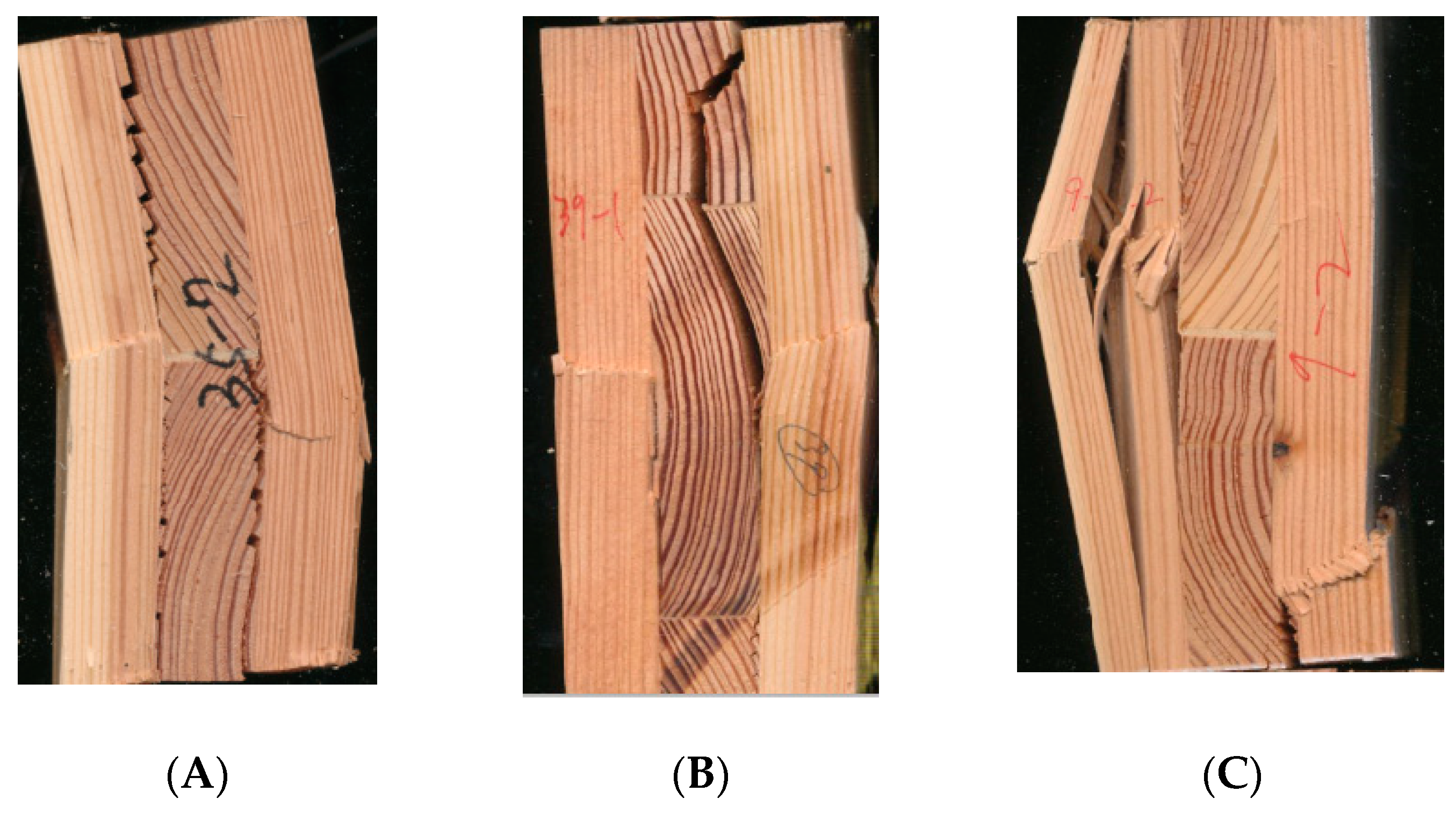
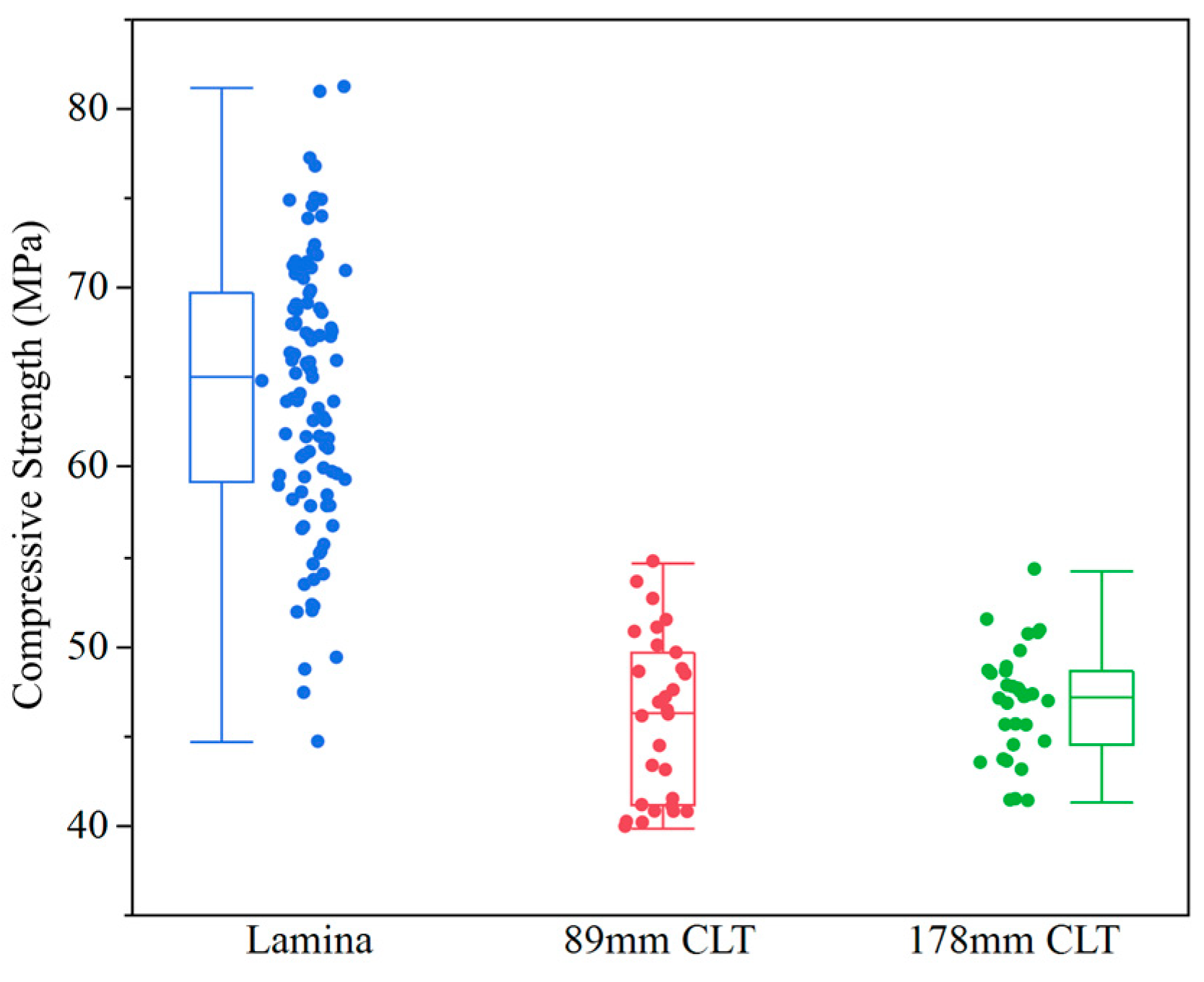

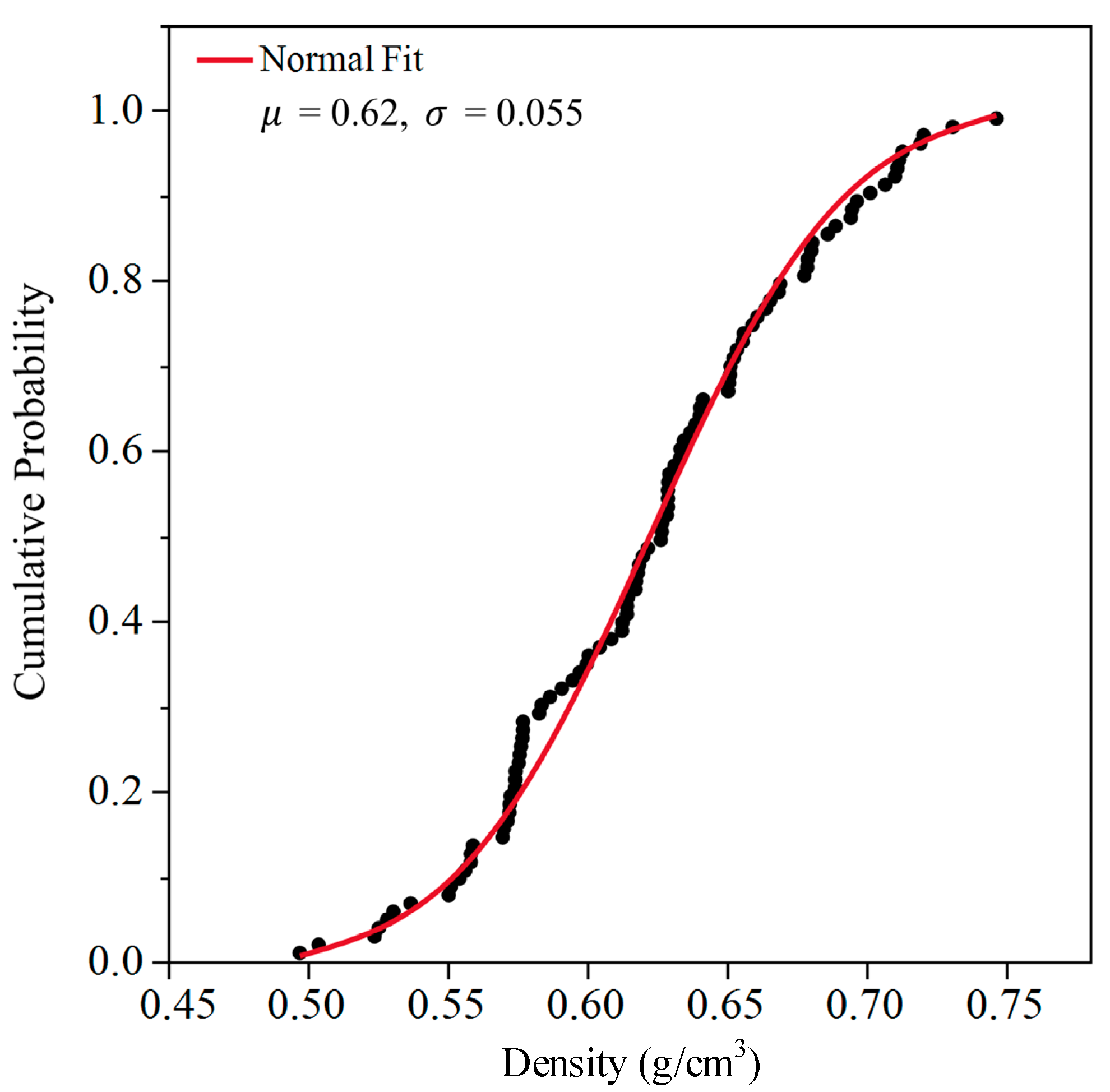
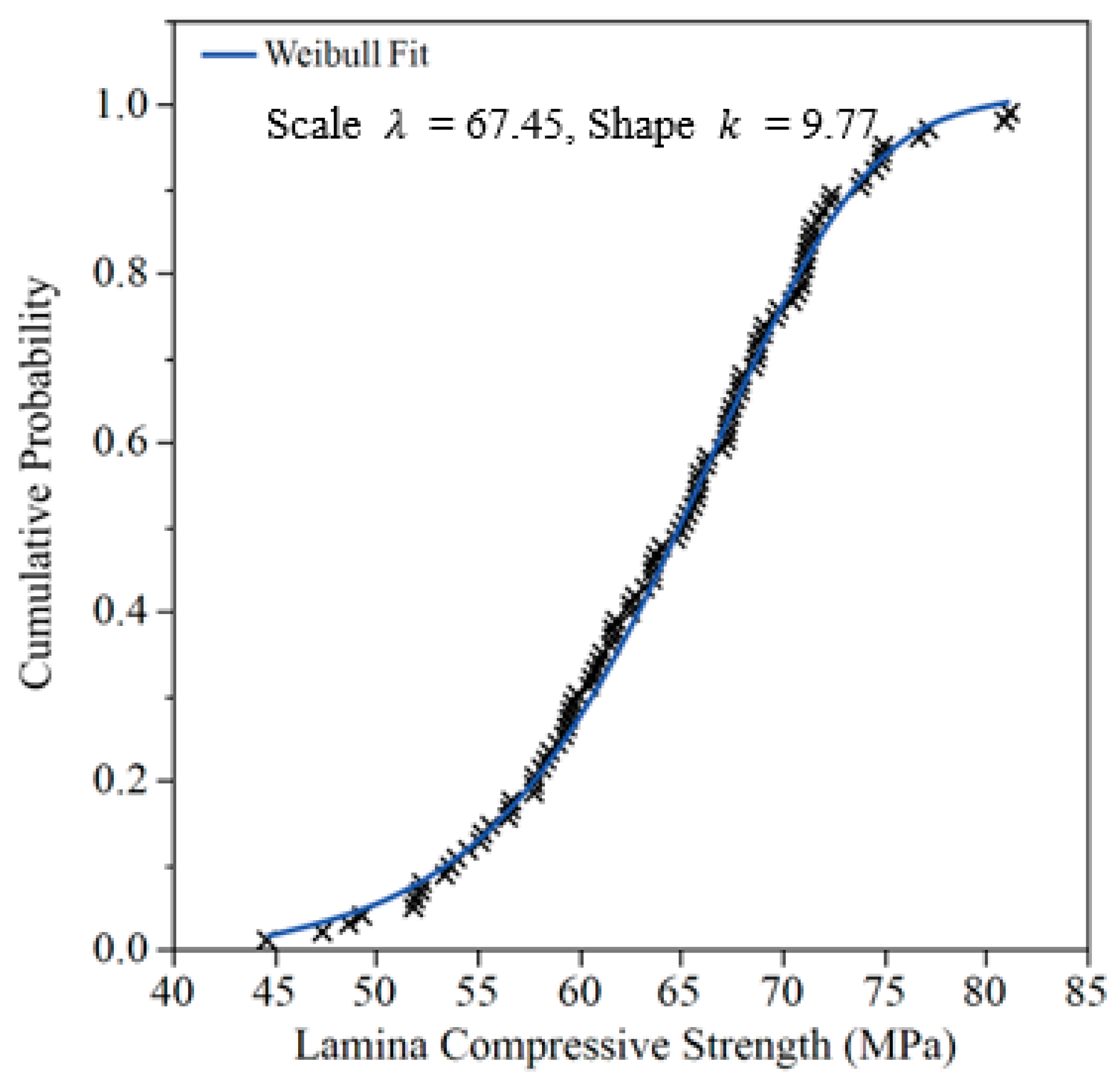


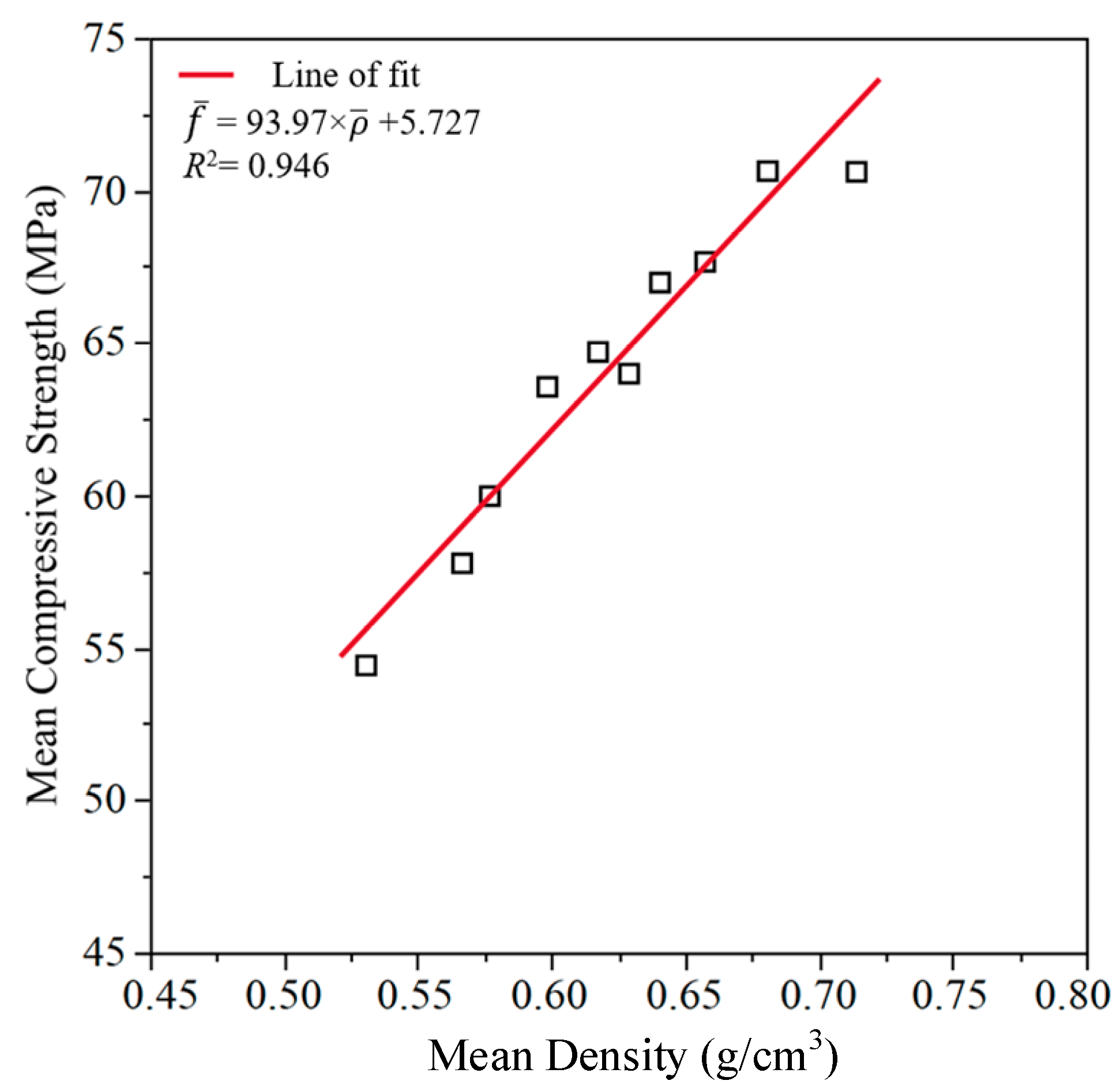

| Normal | Log-Normal | 2-Parameters-Weibull |
|---|---|---|
| Statistics | Lamina | 89 mm CLT | 178 mm CLT | |||
|---|---|---|---|---|---|---|
| f (MPa) | ρ (g/cm3) | FCLT (MPa) | ρ (g/cm3) | FCLT (MPa) | ρ (g/cm3) | |
| N | 102 | 102 | 30 | 30 | 32 | 32 |
| Mean value | 64.20a | 0.62A | 46.15b | 0.62A | 46.84b | 0.62A |
| Standard deviation | 7.45 | 0.05 | 4.43 | 0.04 | 3.09 | 0.02 |
| Coefficient of variation (%) | 11.61 | 8.77 | 9.59 | 6.84 | 6.61 | 3.85 |
| Minimum value | 44.65 | 0.50 | 39.91 | 0.54 | 41.35 | 0.58 |
| Maximum value | 81.20 | 0.75 | 54.71 | 0.70 | 54.27 | 0.67 |
| 5th percentile value | 51.88 | 0.53 | 40.03 | 0.55 | 41.37 | 0.58 |
| 25th percentile value | 59.19 | 0.58 | 41.35 | 0.59 | 44.51 | 0.60 |
| 50th percentile value | 65.08 | 0.63 | 46.29 | 0.62 | 47.18 | 0.62 |
| 75th percentile value | 69.71 | 0.66 | 49.71 | 0.66 | 48.60 | 0.64 |
| 95th percentile value | 74.95 | 0.71 | 54.08 | 0.69 | 52.45 | 0.67 |
| Source | DF | Sum of Squares | Mean Square | F Ratio | Prob > F (p Value) |
|---|---|---|---|---|---|
| CLT Wide | 1 | 7.41138 | 7.4114 | 0.5142 | 0.4761 |
| Error | 60 | 864.88347 | 14.4147 | ||
| Total | 61 | 872.29486 |
| Assumed Distribution | Parameter | Whether to Accept the Assumed Model | ||||
|---|---|---|---|---|---|---|
| Normal distribution | Location | 0.62 | 0.0790 | 0.0877 | Yes | 0.0612 |
| Dispersion | 0.05 | |||||
| Log-normal distribution | Scale | −0.48 | 0.0753 | 0.0877 | Yes | 0.0692 |
| Shape | 0.088 | |||||
| Weibull distribution | Scale | 0.65 | 0.0709 | 0.0879 | Yes | 0.1326 |
| Shape | 12.43 | |||||
| Assumed Distribution | Parameter | Whether to Accept the Assumed Model | ||||
|---|---|---|---|---|---|---|
| Normal distribution | Location | 64.20 | 0.0571 | 0.0877 | Yes | 0.0557 |
| Dispersion | 7.45 | |||||
| Log-normal distribution | Scale ) | 4.16 | 0.1001 | 0.0877 | No | 0.2054 |
| Shape | 0.12 | |||||
| Weibull distribution | Scale | 67.45 | 0.0412 | 0.0879 | Yes | 0.0249 |
| Shape | 9.77 | |||||
| Method | Prediction Model of Lamina | Prediction Equation | Prediction Error (MPa) | Model | ||
|---|---|---|---|---|---|---|
| a | b | R2 | ||||
| Regression line of test result | 93.97 | 5.69 | 0.473 | + 5.69 | 4.23 | A |
| Monte Carlo simulation | 103.10 | 0 | 0.999 | 1.36 | B | |
| Monte Carlo simulation | 94.23 | 5.52 | 0.466 | + 5.52 | 1.37 | C |
| Sorting by density | 93.97 | 5.27 | 0.946 | + 5.27 | 1.03 | D |
| Method | Prediction Equation of Lamina | Prediction Equation for CLT | Model | ||
|---|---|---|---|---|---|
| a | b | R2 | |||
| Regression line of test result | 93.97 | 5.69 | 0.473 | + 4.10 | A |
| Monte Carlo simulation | 103.10 | 0 | 0.999 | B | |
| Monte Carlo simulation | 94.23 | 5.52 | 0.466 | + 3.97 | C |
| Sort by density | 93.97 | 5.27 | 0.946 | + 3.79 | D |
| CLT Width | Average Density (g/cm3) | Average Compressive Strength (MPa) | Predicted Compressive Strength of CLT (MPa) | Prediction Error (MPa) | ||||||
|---|---|---|---|---|---|---|---|---|---|---|
| A | B | C | D | A | B | C | D | |||
| 89 mm | 0.58 ± 0.02 | 43.16 ± 2.96 | 43.66 | 43.41 | 43.65 | 43.69 | 0.50 | 0.25 | 0.48 | 0.53 |
| 89 mm | 0.65 ± 0.03 | 48.77 ± 3.83 | 48.33 | 48.54 | 48.33 | 48.36 | 0.43 | 0.23 | 0.43 | 0.40 |
| 178 mm | 0.60 ± 0.01 | 45.89 ± 2.35 | 44.49 | 44.32 | 44.48 | 44.52 | 1.39 | 1.56 | 1.40 | 1.36 |
| 178 mm | 0.64 ± 0.02 | 47.69 ± 3.48 | 47.12 | 47.20 | 47.11 | 47.15 | 0.57 | 0.48 | 0.57 | 0.54 |
Publisher’s Note: MDPI stays neutral with regard to jurisdictional claims in published maps and institutional affiliations. |
© 2022 by the authors. Licensee MDPI, Basel, Switzerland. This article is an open access article distributed under the terms and conditions of the Creative Commons Attribution (CC BY) license (https://creativecommons.org/licenses/by/4.0/).
Share and Cite
Tian, Z.; Gong, Y.; Xu, J.; Li, M.; Wang, Z.; Ren, H. Predicting the Average Compression Strength of CLT by Using the Average Density or Compressive Strength of Lamina. Forests 2022, 13, 591. https://doi.org/10.3390/f13040591
Tian Z, Gong Y, Xu J, Li M, Wang Z, Ren H. Predicting the Average Compression Strength of CLT by Using the Average Density or Compressive Strength of Lamina. Forests. 2022; 13(4):591. https://doi.org/10.3390/f13040591
Chicago/Turabian StyleTian, Zhaopeng, Yingchun Gong, Junhua Xu, Mingyue Li, Zhaohui Wang, and Haiqing Ren. 2022. "Predicting the Average Compression Strength of CLT by Using the Average Density or Compressive Strength of Lamina" Forests 13, no. 4: 591. https://doi.org/10.3390/f13040591
APA StyleTian, Z., Gong, Y., Xu, J., Li, M., Wang, Z., & Ren, H. (2022). Predicting the Average Compression Strength of CLT by Using the Average Density or Compressive Strength of Lamina. Forests, 13(4), 591. https://doi.org/10.3390/f13040591






